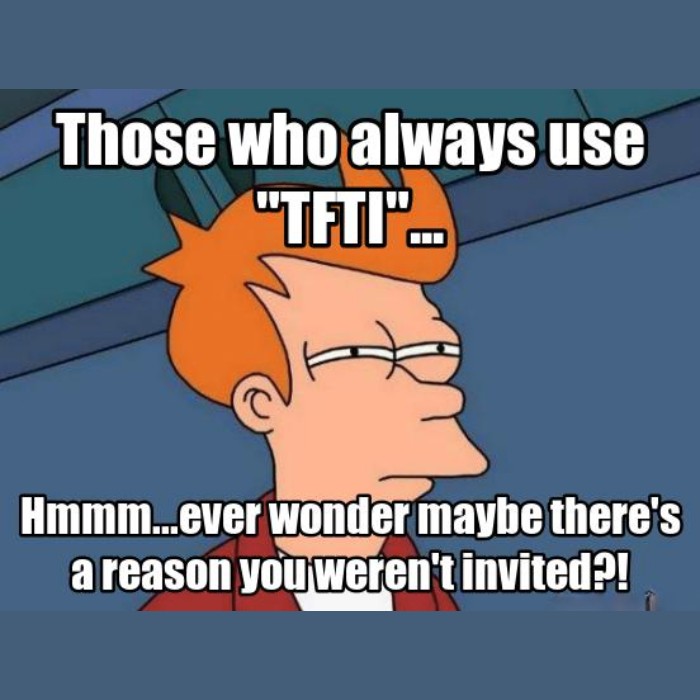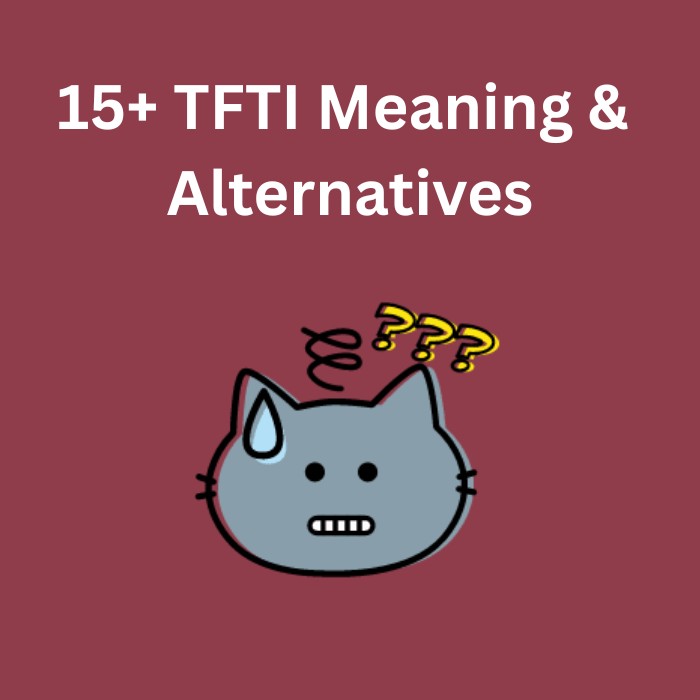The term “TFTI” has become a staple in digital communication, often leaving many puzzled about its exact meaning. Understanding TFTI meaning text is crucial for navigating modern conversations, especially in social media and texting contexts.
In this article, I will explore over 15+ meanings of TFTI, provide context on when to use them, and offer practical responses to ensure your replies resonate with the intended audience.
With this insight, you’ll not only decode conversations but also enhance your ability to connect meaningfully with others.
What Does TFTI Mean?
TFTI, an abbreviation for “Thanks for the invite,” has evolved into a casual yet pointed expression commonly found in digital conversations. This phrase often conveys a mix of sarcasm and genuine disappointment when someone feels left out of an event or gathering.

In today’s fast-paced social media landscape, where invitations can be shared with a simple click, the use of TFTI serves as a reminder of the importance of inclusivity and connection among friends and acquaintances.
When people use TFTI, it typically reflects their desire to be acknowledged and included in social circles. The tone can vary significantly based on context; for instance, it might be used lightheartedly among close friends or more seriously when addressing feelings of exclusion.
The multifaceted nature of TFTI allows it to serve as both a humorous quip and a candid expression of one’s emotional response to social dynamics.
15+ Alternative Ways to Say TFTI (Based on Tone & Context)
There are 15+ alternative ways to say TFTI that can better convey your feelings based on tone and context. For a light-hearted approach, consider phrases like “Next time, right?” or “Guess I’ll just have to throw my party!” These options maintain a playful vibe while hinting at your disappointment.
Polite and Professional Alternatives
If you require a more formal or professional method to respond to an invitation, these options are effective:
Thank you for the invitation; I appreciate it.
Expressing gratitude sets a positive tone and acknowledges the effort behind the invitation, fostering goodwill.
I regret to inform you that I cannot attend.
This straightforward response maintains professionalism while clearly indicating your unavailability without sounding dismissive.
I wish I could join, but I have prior commitments.
This option conveys your appreciation for the invite while subtly hinting at your busy schedule, making it relatable.
I am honored by your invitation, but I must decline.
This response emphasizes respect for the host’s gesture and establishes a courteous relationship, even in absence.
Please keep me in mind for future gatherings.
This shows continued interest and willingness to engage in future events, keeping the door open for more connections down the line.
Casual and Friendly Alternatives

For casual chats, these replies aid in maintaining a fun and interesting atmosphere:
“Oh wow, thanks for the invite!”
A friendly and natural response to an invitation.
“Appreciate the heads-up!”
Group chats or casual social gatherings.
“Nice! Count me in!”
Excitedly accepting an invitation.
“Sounds fun! Thanks for letting me know!”
Best for: Casual, polite acknowledgment.
“I’m in! Thanks for thinking of me!”
Best for: Letting someone know you’re attending with enthusiasm.
Sarcastic or Playful Responses
If you’re playfully teasing friends for not including you, here are humorous and lighthearted methods to express it:
“Wow, didn’t know I was left off the guest list!”
Playfully teasing close friends.
“Oh, cool, must have lost my invite in the mail!”
A humorous way to acknowledge being left out.
“Guess I’ll just sit at home and cry.”
Exaggerated sarcasm to keep things light.
“Okay, okay, I see how it is.”
Friendly banter with a hint of FOMO (Fear of Missing Out).
“Enjoy your exclusive party, I guess.”
A dramatic but funny response to being left out.
How to Choose the Best Alternative to TFTI
When deciding how to reply, take into account these elements:
Your Relationship: Close friends might understand sarcasm, but a boss or acquaintance might not.
The Situation: Is it a professional setting, casual chat, or social media comment?
Your Tone: Do you want to sound polite, playful, or a little sarcastic?
10 Texting Examples of How to Use These Alternatives
Here are 10 straightforward text message examples to assist you in using these alternatives seamlessly:

Polite Response
Friend: “Hey, we’re having a get-together this weekend. Wanna come?”
You: “Thanks for including me! I’d love to join!”
Professional Response
Work Email: “We’d love for you to attend our networking event next Friday.”
You: “I appreciate the invitation! Looking forward to it.”
Casual Response
Friend: “We’re grabbing dinner tonight. Wanna come?”
You: “Sounds fun! Thanks for letting me know!”
Excited Response
Friend: “You’re invited to my birthday party next Saturday!”
You: “Nice! Count me in!
Playful Teasing
Friend: “We just had an amazing beach day!”
You: “Wow, must have lost my invite in the mail.
Sarcastic Response
Friend Posts on Instagram: “Had an amazing dinner with the squad!”
You (commenting): “Okay, okay, I see how it is.
Friendly Acknowledgment
Friend: “We’re all meeting up at 8 tonight. Hope you can come!”
You: “Appreciate the heads-up! I’ll try to make it!”
Humble Response
Friend: “You’re always invited, no need to ask!”
You: “That means a lot! Thanks for thinking of me.”
Joking with Friends
Friend: “We just booked a group trip to Vegas!”
You: “Oh, cool, I love hearing about trips I wasn’t invited to.
Grateful Response
Friend: “We’d love for you to be there!”
You: “I’m grateful for the invite! I’ll be there.”
Conclusion
Understanding the TFTI meaning is essential for effective communication in today’s digital age. This tfti acronym, which stands for “Thanks For The Invite,” can often carry different connotations depending on the context.
By exploring various alternatives and appropriate responses, you can navigate social situations more adeptly. Whether you’re responding to a casual invite or addressing a missed opportunity, knowing how to use TFTI correctly can enhance your interactions.

